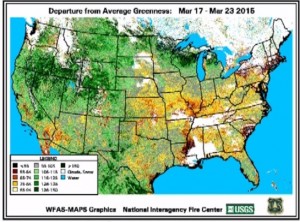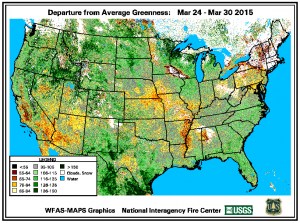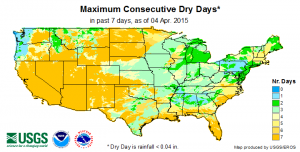Here are a couple of sites that you might find useful in looking at current conditions across the United States. The two maps below show the departure from average greenness across the United States from the US Forest Service. You can find these maps at https://www.wfas.net/index.php/avhrr-ndvi-moisture–drought-47. They show satellite-derived vegetation status across the country. These particular maps show the departure of greenness from average conditions, so that areas in green are ahead of average and areas in brown and yellow are behind average. Areas in white have missing data due to the persistent presence of clouds during the data collection period.
In the maps below you can see that there have been significant improvements in greenness across most of the Southeast. The warm weather and precipitation in the last week has really helped to improve conditions here. The exception is in northern Alabama and in southern Florida. I think the problems in Alabama may be due in part to the excess rain which has plagued that part of the country, leading to reduced sunlight and standing water in some areas. In south Florida, the absence of rain has contributed to the development of drought and stress on the plants there.
If you are interested in looking at the number of rainy days we have had over time, you might want to visit another site hosted by the US Geological Survey. This site, at https://earlywarning.usgs.gov/usraindry/, shows the number of wet and dry days over time. This can show why hay is not drying well or why it is so hard to get into the fields due to the lack of enough dry days. A couple of examples of the maps available at that site are shown below. For example, the map of maximum consecutive dry days shows that in northern Georgia and Alabama, in the past week there was never more than two days between rain events, which may have caused delays in planting, while in south Georgia and Florida, almost the entire week has been dry, leading to problems with soil moisture and germination.



